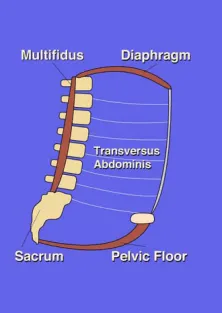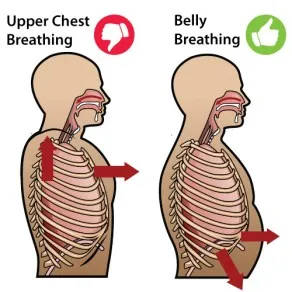Most of us probably heard of the diaphragm that lives under the lungs and helps us breath right? But have you heard of the pelvic diaphragm ? The 2nd layer of the pelvic floor muscles is referred to as the pelvic diaphragm. Both these structures are anatomically positioned to be parallel to each other .

Now let me talk a little bit about pelvic pain. Pelvic pain can be due to many reasons. Irrespective of the underlying pathology the common finding as a response to pathology is a tight or shortened pelvic floor. When PFM (pelvic floor muscles ) are tight the functions of the pelvic floor are hampered so the person may have complaints of
- constipation ( can include men )
- difficulty with initiating urination
- pain with intercourse

Now let’s connect breathing and pelvic pain ! Yes deep breathing can help pelvic pain and here’s what happens when you take a diaphragmatic ( deep belly breath ) breath , the abdominal diaphragm contracts and pelvic diaphragm relaxes .The two diaphragms are positioned in such a manner that when doing deep breathing the abdominal diaphragm contracts and causes the abdominal contents ( intestine and stomach) to descend into the pelvis and in turn will cause the pelvic diaphragm/ the muscles in the pelvis to lengthen/ relax .The opposite happens when we exhale , the diaphragm relaxes and the abdominal organs move up and away from the pelvic floor and the pelvic floor contracts.

Repeating this as an exercise for 5 to 10 minutes for about 1-2 x /day is a good start to start learning to relax the pelvic floor. This is excellent to relax your mind as well, prior to mediation or in conjunction with mediation .
In my experience I see people who carry their stress and tension in two places. In their shoulder ( upper trapezius muscles) and in the pelvic floor! Yes ! you read that right ! in the Pelvic floor !. This is my finding in my practice ,when I teach patients to correct their posture and relax their shoulders this helps with the pelvic pain as well over time.

So how is this Diaphragmatic breathing done ?
- Start by laying down ( with knees bent ) or sitting down comfortably .
- Place one hand on the chest .
- Place the 2nd hand on the abdomen around the belly button .
- Take a nice deep breath in through your nose, your hand on the chest should not feel much movement but the hand on your belly should rise up slightly .
- Do not forcefully push your belly out .
- Gently breath out through pursed lips.
- Wait for about 1 min and repeat slowly for about 5 min.
Some final thoughts This kind of breathing might feel awkward if you are used to shallow breathing using the upper chest , it will take some time to retraining .
This is also a good exercise for people with COPD ( chronic obstructive pulmonary diseases) and can help lung function .If you experience lightheadedness , discontinue the deep breathing consult your PT to be trained to do the exercises appropriately .

